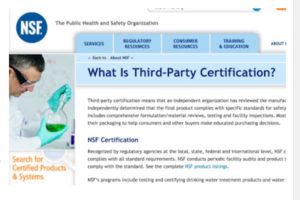Blockchain Certify Food Imports from China
Food safety is always a challenge. Insuring food safety from suppliers in distant countries like China is even more of a challenge. “Blockchain: A Better Way to Track Pork Chops, Bonds, Bad Peanut Butter?,” (New York Times, March 4, 2017) report new applications of Bitcoin’s blockchain to food security:
Frank Yiannas has spent years looking in vain for a better way to track lettuce, steaks and snack cakes from farm and factory to the shelves of Walmart, where he is the vice president for food safety. When the company dealt with salmonella outbreaks, it often took weeks to trace where the bad ingredients came from.
Then, last year, IBM executives flew to Walmart’s headquarters in Arkansas to propose a solution: the blockchain.
 Blockchain, the encryption protocol backing Bitcoin security is deployed for supply chain security. Modern manufacturing as well as food production is often spread across a wide network of suppliers around the world. All major companies from Ford and Toyota to Nike and Walmart hire third-party certification services both to monitor quality standards and working conditions with suppliers.
Blockchain, the encryption protocol backing Bitcoin security is deployed for supply chain security. Modern manufacturing as well as food production is often spread across a wide network of suppliers around the world. All major companies from Ford and Toyota to Nike and Walmart hire third-party certification services both to monitor quality standards and working conditions with suppliers.
Nike never wants their shoes made by untraceable factories using low-quality materials, nor face news stories of Nike subcontractor factories with unsafe working conditions. Similarly Walmart and other companies selling food want to certify standards and safety from the original farms, through processing and distribution.
Blockchain provides an accounting system that makes it hard for later links in the supply chain to falsify earlier links (to hide low-cost unapproved suppliers, for example).
“Walmart and IBM Are Partnering to Put Chinese Pork on a Blockchain,” (Fortune, October 16, 2017) begins:
A decade ago in the United States, a deadly strain of E. coli in tainted spinach ripped through 26 states, killing three people and sickening more than 200. The outbreak represents what can happen when sourcing food—and tracing contaminations—goes horribly wrong.
“Consumers, in general, stopped eating spinach. Restaurants pulled it off the menu,” says Frank Yiannas, vice president of food safety at Walmart (WMT, -0.36%). “If you could track and pinpoint where that came from faster, you could alleviate all that and ensure consumer confidence continues.” …
Walmart plans to use technology developed by the Hyperledger Project, an open source software project that builds blockchain tools and is based out of the Linux Foundation, a non-profit organization that maintains the code for a popular eponymous operating system.
Nearly half a trillion dollars world of goods were shipped (or flown) from China to the US in 2016, and a significant part of the cost is documenting these goods. Maersk is a major shipping firm facing this challenge:
For Maersk, the problem was not tracking the familiar rectangular shipping containers that sail the world aboard its cargo ships — instead, it was the mountains of paperwork that go with each container. Maersk had found that a single container could require stamps and approvals from as many as 30 people, including customs, tax officials and health authorities.
…The cost of moving and keeping track of all this paperwork often equals the cost of physically moving the container around the world.
What’s more, the system is rife with fraud. The valuable bill of lading is often tampered with or copied to let criminals siphon off goods or circulate counterfeit products, leading to billions of dollars in maritime fraud each year.
Shipping fraud leads to food safety risks for companies like Walmart (and, of course, for customers).
FDA and USDA food safety agencies, apart from turf fights with each other, are challenged by incentive, information, and budget issues.
FDA/USDA Catfish fights offer a turf-war example. “Senate votes to end USDA catfish inspections, which just got underway,” (Food Safety News, May 26, 2016)
The U.S. Senate has voted to shut down the nation’s only catfish inspection program, a move that would put more Americans at risk of exposure to carcinogens and antibiotics from Asian white fish, such as Vietnamese pangasius.
…If it passes the House, it would still have to be signed by President Obama before the U.S. Department of Agriculture (USDA) catfish inspection program would be shut down. If that happens, catfish would likely revert back to the U.S. Food and Drug Administration (FDA), where only 1 to 2 percent of seafood imports are inspected because of budget constraints.
Sounds scary, but Food Safety News has its own perspective and bias, according to a NPR story discounting a Food Safety News scare story on supermarket honey, “Relax, Folks. It Really Is Honey After All,”
Maybe we’re too inclined to believe the worst about supermarket food.
How else to explain the reaction to a recent report about honey on the web site Food Safety News? Food Safety News is published by a lawyer who represents plaintiffs in lawsuits against food manufacturers and processors.
The post, by journalist Andrew Schneider, claimed that most honey on supermarket shelves isn’t really honey. As evidence, the site cited tests showing that there is no pollen in most of that honey. (Raw honey contains lots of pollen, which bees collect along with the nectar that they turn into honey.)
The Food Safety News story in NPR post focused on allegedly unsafe honey from China:
The article implied that this was part of a deliberate attempt to prevent anyone from detecting illicit honey from China. (The United States blocks imports of Chinese honey because U.S. officials decided that it was being sold at artificially low prices, undercutting American honey producers.) Schneider also reminded his readers that Chinese honey has had a history of safety problems, including contamination with banned antibiotics and lead.
This 2011 NRP story is valuable for its in-depth research on the honey industry, and gives a glimpse of the way many food safety scares (and lawsuits) develop.
One avenue to incentivize companies to keep food safe is to avoid expensive litigation and awards to customers hurt by unsafe food. Bad publicity provides a powerful incentive as well, as Chipote management and stockholders learned recently.
 Most of economics is about incentives, and it is an open debate whether food safety regulations, potential litigation, or fear of bad publicity plays the larger role in maintaining and improving food safety. Critics of the FDA and USDA regulatory approach focus in agency incentives.
Most of economics is about incentives, and it is an open debate whether food safety regulations, potential litigation, or fear of bad publicity plays the larger role in maintaining and improving food safety. Critics of the FDA and USDA regulatory approach focus in agency incentives.
Government agencies suffer from incentive and information problems that slow innovation and hamper alternative food safety systems. Students have an opportunity to research the dozens of food safety certification systems that have developed to protect consumers.
A major concern with both domestic and imported food is possible overuse or misuse of pesticides and herbicides. Interesting to see how significantly U.S. pesticide and herbicide use has fallen, even as agricultural production has increased:
May 2014, the National Agricultural Statistics Service at the U.S. Department of Agriculture (USDA) issued its comprehensive report Pesticide Use in U.S. Agriculture. The agency found that herbicide usage peaked at 478 million pounds in 1981—a decade and half prior to the introduction of the first biotech crop varieties—and fell to 394 million pounds in 2008. So instead of the massive increase in herbicide spraying claimed by Benbrook, the USDA actually reports a modest decline. Insecticide applications peaked in 1972 at 158 million pounds, dropping to 29 million pounds in 2008. [Source: Chipotle Treats Customers Like Idiots, Aug./Sept. 2015 Reason]
